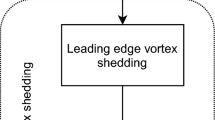Abstract
Numerous studies on the aerodynamics of insect wing flapping were carried out on different approaches of flight investigations, model experiments, and numerical simulations, but the theoretical modeling remains to be explored. In the present paper, an analytic approach is presented to model the flow interactions of wing flapping in air for small insects with the surrounding flow fields being highly unsteady and highly viscous. The model of wing flapping is a 2-D flat plate, which makes plunging and pitching oscillations as well as quick rotations reversing its positions of leading and trailing edges, respectively, during stroke reversals. It contains three simplified aerodynamic assumptions: (i) unsteady potential flow; (ii) discrete vortices shed from both leading and trailing edges of the wing; (iii) Kutta conditions applied at both edges. Then the problem is reduced to the solution of the unsteady Laplace equation, by using distributed singularities, i.e., sources/sinks, and vortices in the field. To validate the present physical model and analytic method proposed via benchmark examples, two elemental motions in wing flapping and a case of whole flapping cycles are analyzed, and the predicted results agree well with available experimental and numerical data. This verifies that the present analytical approach may give qualitatively correct and quantitatively reasonable results. Furthermore, the total fluid-dynamic force in the present method can be decomposed into three parts: one due to the added inertial (or mass) effect, the other and the third due to the induction of vortices shed from the leading-and the trailing-edge and their images respectively, and this helps to reveal the flow control mechanisms in insect wing flapping.
Similar content being viewed by others
References
Ellington CP, et al. Leading-edge vortices in insect flight.Nature, 1996, 384: 626–630
Dickinson MH, Lehmann FO, Sane SP. Wing rotation and the aerodynamic basis of insect flight.Science, 1999, 284: 1954–1960
Sun M, Tang J. Unsteady aerodynamic force generation by a model fruit fly wing in flapping motion.J Exp Biol 2002, 205: 55–70
Sun M, Tang J. Lift and power requirements of hovering flight in Drosophila virilis.J Exp Biol, 2002, 205: 2413–2427
Wu TY. On theoretical modeling of aquatic and aerial animal locomotion.Adv Appl Mech, 2001, 38: 291–353
Żbikowski R. On aerodynamic modeling of an insect-like flapping wing in hover for micro-air vehicles.Phil Trans R Soc Lond A, 2002, 360: 273–290
Lighthill J. Mathematical Biofluiddynamics. SIAM, 1975
Ellington CP. The aerodynamics of hovering insect flight. II. Morphological parameters.Phil Trans R Soc Lond B, 1984, 305: 17–40
Theodorsen T. General theory of aerodynamic instability and mechanism of flutter. NACA Report 496, 1935
Wu JC. Theory for aerodynamic force and moment in viscous flow.AIAA J, 1981, 19(4): 432–441
Dickinson MH, Götz KG. Unsteady aerodynamic performance of model wings at low Reynolds number.J Exp Biol, 1993, 174: 45–64
Hamdani H, Sun M. Aerodynamic forces and flow structures of an airfoil in some unsteady motions at small Reynolds number.Acta Mechanica, 2000, 145: 173–187
Author information
Authors and Affiliations
Additional information
The project supported by the National Natural Science Foundation of China (10072066) and the Chinese Academy of Sciences (KJCX-SW-LO4, KJCX2-SW-L2)
Rights and permissions
About this article
Cite this article
Yongliang, Y., Binggang, T. & Huiyang, M. An analytic approach to theoretical modeling of highly unsteady viscous flow excited by wing flapping in small insects. Acta Mech Sinica 19, 508–516 (2003). https://doi.org/10.1007/BF02484543
Received:
Revised:
Issue Date:
DOI: https://doi.org/10.1007/BF02484543




